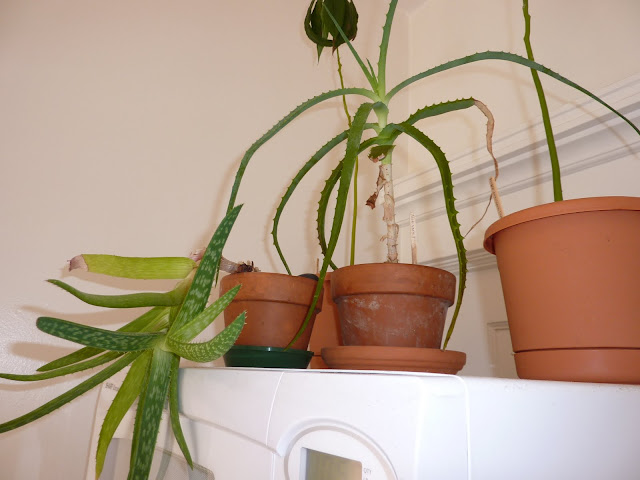I was going to write about how I acquired these seeds but I don't want to self incriminate. Basically, I came into some baobab seeds in 2005 that were obtained from southern Senegal, outside Cap Skirring by the border with Guinea-Bissau. Here is a photo of the tree that the seeds came from:
 You can see, up in the tree, fruits of the baobab tree. Another common name for the baobab is the dead-rat tree. The fruits hang down from the branches and slightly resemble dead rats. If you ask me they look more like opossums. Here is a close up of the fruit the seeds came out of:
You can see, up in the tree, fruits of the baobab tree. Another common name for the baobab is the dead-rat tree. The fruits hang down from the branches and slightly resemble dead rats. If you ask me they look more like opossums. Here is a close up of the fruit the seeds came out of: Baobab fruit is quite pleasant tasting. The fruit dries out on the tree and is the size and shape of an American football. There is a hard husk that must be cracked in order to expose the edible inner part. Inside is a white, starchy dry fruit that has a lightly sweet, acidic flavor. You can break off a piece and let it dissolve in your mouth over several minutes. All that will remain are black rock-hard seeds about the size and shape of a pinto bean.
Baobab fruit is quite pleasant tasting. The fruit dries out on the tree and is the size and shape of an American football. There is a hard husk that must be cracked in order to expose the edible inner part. Inside is a white, starchy dry fruit that has a lightly sweet, acidic flavor. You can break off a piece and let it dissolve in your mouth over several minutes. All that will remain are black rock-hard seeds about the size and shape of a pinto bean.I put my seeds in a plastic bag and forgot about them for about 4 years. I encountered them one day while cleaning and decided to dump them into one of my seed pots. After a couple of months 4 of the seeds sprouted (out of approximately 50). They sent up a pair of large cotyledons that were stuck inside the partially intact seed casing. Only 1 of the 4 plants freed itself from the seed. The other 3 I tried to carefully extract; however, I ended up tearing the cotyledons fairly severely. Luckily they all survived and grew into cute little trees.
 Each of my baobabs has its own look and personality. Some have deep green leaves, while others are lighter. The leaf shapes are also a bit different. Some are more oval while some have a point. Some have dentation while others are entire. I have read that you can completely desiccate them during the dry season, but I didn't have the heart. Maybe I'll try that with one of them next year.
Each of my baobabs has its own look and personality. Some have deep green leaves, while others are lighter. The leaf shapes are also a bit different. Some are more oval while some have a point. Some have dentation while others are entire. I have read that you can completely desiccate them during the dry season, but I didn't have the heart. Maybe I'll try that with one of them next year. People also call baobabs the upside-down trees. Their trunks and branches are stubby and look like roots. The trunks store a massive amount of water. I was impressed at how thick the stems were of my baby little trees even after a month or so of growth; however, the real surprise revealed itself when I repotted one of them. Just under the surface of the soil is a massive water storage organ/tap root. You can see it peaking out of the ground in this photo. As you can see it is really thick compared to the trunk.
People also call baobabs the upside-down trees. Their trunks and branches are stubby and look like roots. The trunks store a massive amount of water. I was impressed at how thick the stems were of my baby little trees even after a month or so of growth; however, the real surprise revealed itself when I repotted one of them. Just under the surface of the soil is a massive water storage organ/tap root. You can see it peaking out of the ground in this photo. As you can see it is really thick compared to the trunk. I am crossing my fingers that more of the baobab seeds will sprout this growing season. I still have a few dozen seeds in my seed pot. If anyone knows of baobabs growing in the Bay Area, please let me know.
I am crossing my fingers that more of the baobab seeds will sprout this growing season. I still have a few dozen seeds in my seed pot. If anyone knows of baobabs growing in the Bay Area, please let me know.


























